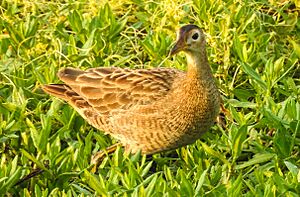Watercock facts for kids
Quick facts for kids Watercock |
|
|---|---|
 |
|
| Male at Basai Wetlands, near Gurgaon, Haryana, India | |
| Conservation status | |
| Scientific classification | |
| Genus: |
Gallicrex
|
| Species: |
cinerea
|
The Watercock (Gallicrex cinerea) is a cool water bird. It belongs to the rail and crake family, called Rallidae. You can find these birds all over Southeast Asia. The Watercock is the only bird in its special group, called Gallicrex.
Contents
About the Watercock's Name
Scientists give every animal a special name. This helps everyone know exactly which animal they are talking about! The Watercock got its official name in 1789. A German scientist named Johann Friedrich Gmelin first described it. He put it in a group with birds called coots.
Later, in 1852, Edward Blyth created the special group Gallicrex just for the Watercock. The name Gallicrex combines two other bird names: Gallus (like chickens) and Crex (another type of rail). The second part of its name, cinerea, comes from a Latin word. It means "ash-grey," which describes some of its colors.
There are no different types or subspecies of Watercocks. They are all the same species.
What Does a Watercock Look Like?
Watercocks look different depending on if they are male, female, or young.
Male Watercocks
Adult male Watercocks are about 43 centimeters (17 inches) long. They weigh between 476 and 650 grams (about 1 to 1.4 pounds). Most of their feathers are dark black-grey. They have bright red legs, a red beak, and a red shield-like growth on their forehead.
Young male Watercocks start out a buff (light yellowish-brown) color. As they get older, their feathers become darker. Their beak is yellow, and their legs are green.
Female Watercocks
Female Watercocks are smaller than males. They are about 36 centimeters (14 inches) long. They weigh between 298 and 434 grams (about 10.5 to 15.3 ounces). Their top feathers are dark brown. Their belly feathers are lighter. They have streaks and bars of darker marks on their body. Their beak is yellow, and their legs are green.
Chicks
Baby Watercocks, called chicks, are black. This is common for all baby rails.
Body Shape
The Watercock's body is flat on the sides. This helps them move easily through tall reeds and thick plants. They have long toes, which are good for walking on muddy ground. They also have a short tail.
Watercocks are usually shy birds. They like to stay hidden. But sometimes you can see them out in the open. They are noisy birds, especially early in the morning and late in the evening. They make a loud, gulping sound.
Where Do Watercocks Live?
Watercocks live in swamps and wet areas. They breed in many parts of south Asia. You can find them from India, Pakistan, and Sri Lanka all the way to south China, Korea, Japan, the Philippines, and Indonesia. Most Watercocks stay in these areas all year round. They do not usually migrate.
Watercock Life and Habits
Reproduction
Watercocks build their nests on the ground. They choose a dry spot within marshy plants. Female Watercocks usually lay 3 to 6 eggs in their nest.
Food and Feeding
Watercocks find their food by poking their beak into mud or shallow water. They also pick up food they see. They mostly eat insects and small fish. They also eat seeds. They look for food on the ground.
Gallery





